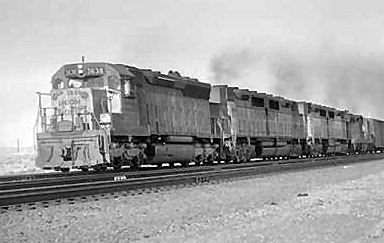Difference between revisions of "V20"
Jump to navigation
Jump to search
m |
|||
| (One intermediate revision by the same user not shown) | |||
| Line 1: | Line 1: | ||
| + | [[Image:UP_SD45_and_DD35.jpg|thumb|right|400px]] | ||
| + | |||
A '''V20''' is an [[internal combustion engine]] in [[V engine|V]] configuration, having 20 [[cylinder (engine)|cylinder]]s. | A '''V20''' is an [[internal combustion engine]] in [[V engine|V]] configuration, having 20 [[cylinder (engine)|cylinder]]s. | ||
| Line 8: | Line 10: | ||
| + | |||
| + | {{Automobile configurations}} | ||
{{Piston engine configurations}} | {{Piston engine configurations}} | ||
| + | {{Machine configurations|state=uncollapsed}} | ||
Latest revision as of 20:36, 16 July 2008
A V20 is an internal combustion engine in V configuration, having 20 cylinders.
Engines of this number of cylinders are not common, but this configuration was used in some large diesel engines. For example, the 1960s vintage General Motors Electro-Motive Division EMD SD45 railroad locomotive was fitted with a 20-cylinder EMD 645E3 engine.
The engine name is based on the displacement of each cylinder in cubic inches. In this case 645 inch³ (10.6 L) for each of 20 cylinders - a total of 211 L. Power output is 3,600 horsepower (2.7 MW).
V20 diesel engines have also been used in marine applications: Mercedes-Benz has produced one such engine.
| Piston engine configurations | |
|---|---|
| Straight | Single, 2, 3, 4, 5, 6, 8, 9, 10, 12, 14 |
| V | 2, 4, 5, 6, 8, 10, 12, 16, 20, 24 |
| Flat | 2, 4, 6, 8, 10, 12, 16, H |
| W | 8, 9, 12, 16, 18 |
| Other inline | H, VR, Opposed, U (Square), X |
| Other | Hemi, Radial, Rotary, Pistonless, Deltic, (Wankel) |
| Heat engines | |
|---|---|
| Stroke cycles One • Two • Four • Six • | |
| Engine types Gas turbine • Piston • Jet • Rocket engine • Steam engine • Stirling engine • Tschudi• Twingle Rotary • Wankel • Free-piston • Britalus • Coomber • Swing-piston • Orbital • Quasiturbine | |
| Valves Cylinder head porting • D slide • Four-stroke • Manifold • Multi • Piston • Poppet • Sleeve | |
| Piston layouts Single cylinder • Straight • Opposed • Flat • V • W • H • Deltic • Radial • Rocket engine nozzle • Rotary • Stelzer • Controlled Combustion • Bourke | |
| Motion mechanisms Cam • Connecting rod • Coomber rotary • Crank • Crank substitute • Crankshaft • Linkages (Evans • Peaucellier-Lipkin • Sector straight-line • Watt) • Double acting/differential cylinder | |
| Thermodynamic cycle |
